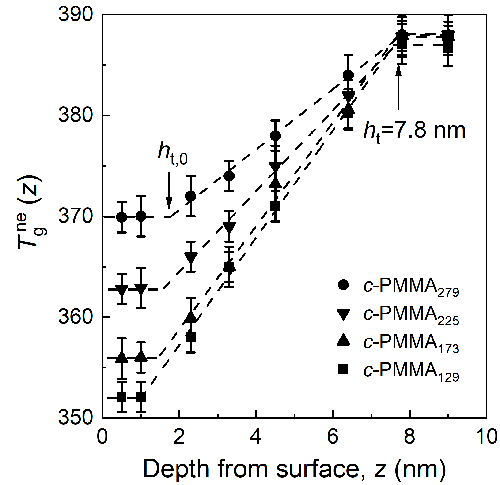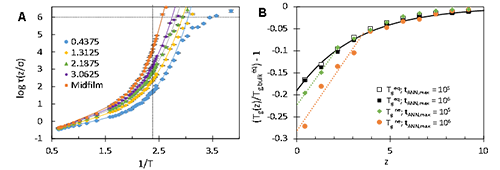納米材料表面的分子狀態是決定材料表面現象(潤濕、摩擦、粘結等)和物理性能(力學、流變、結晶等)的關鍵因素。研究高分子表面分子的弛豫行為不僅有助于尋找調控納米材料性能的新方法,還可為揭示玻璃化的本質這一凝聚態物理長期懸而未決的問題提供新的視角和證據。研究發現,玻璃態高分子表面存在一層運動能力增強的“活性層”;隨著遠離表面,分子運動能力逐漸減弱直至回到本體狀態。然而,對于表面增強分子運動能力的傳遞距離和梯度分布規律的爭論,以及實驗上高空間分辨率測量表面附近局部分子弛豫時間(或玻璃化轉變溫度,Tg)的困難,阻礙了該領域的進一步發展。


Fig. 1. Experimental depth profiles Tgne(z) taken at the surface of various c-PMMA polymers. Dashed lines are the best fits to a linear gradient.

Fig. 2. Simulation results revealing intrinsic nonequilibrium effects on near-surface τ(z) of long-chain films. (A) Segmental relaxation time τ vs. inverse temperature for various segmental layers at different distances z/σ from the surface (σ is the length scale of the bead-spring potential). The dotted lines represent the low-temperature cutoff for inclusion of equilibrium relaxation time data and τ = tANN,max = 106. The curved lines show fits of the data to an established model for equilibrium dynamics. (B) Normalized alteration gradients of Tgeq and Tgne relative to bulk for systems with tANN,max = 105 and 106. The solid line shows a fit of Tgeq (z) to an exponential gradient form to the Tgeq data, while the dotted lines represent linear fits to the surface region.
論文鏈接:www.pnas.org/doi/10.1073/pnas.2406262121
課題組網頁:https://www.chem.zstu.edu.cn/gfzclbjmsys.htm
